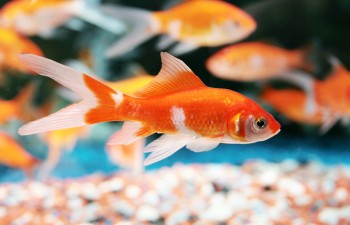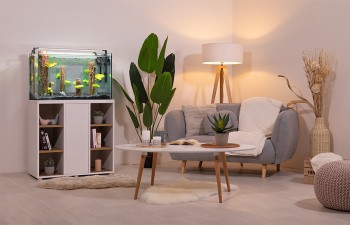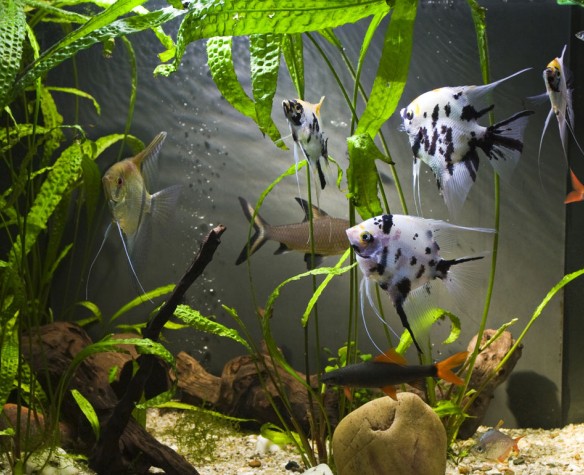
Aquarium heating
The Principle of Thermal Regulation
Keeping an aquarium of so-called “tropical” fish requires putting a heating system in the tank (thermoregulation). The average temperature that has to be maintained for a standard aquarium of tropical fish (entire tank) is around 25° to 27°C. For some varieties, and various treatments, or some kinds of reproduction, temperatures can run between 18° and 33°C, depending on the species and their original biotope.
An aquarium heater is made up of two parts: the heating element called a “resistor” and regulating component called the “thermostat”. In most cases, both components are built into a single unit and are then sometimes called “combined heaters.”
In this case, installation is simple :
- Set the desired temperature using the temperature adjustment knob
- Immerse the unit vertically sticking the suction cups on the back of the aquarium or in the filter’s water inlet compartment
- Dry hands carefully and turn the power on. The built-in thermostat will automatically operate and regulate the heater to maintain a constant temperature in the aquarium. Then you just need to check the temperature of the tank a few hours later using an accurate thermometer and, if necessary, fine tune.
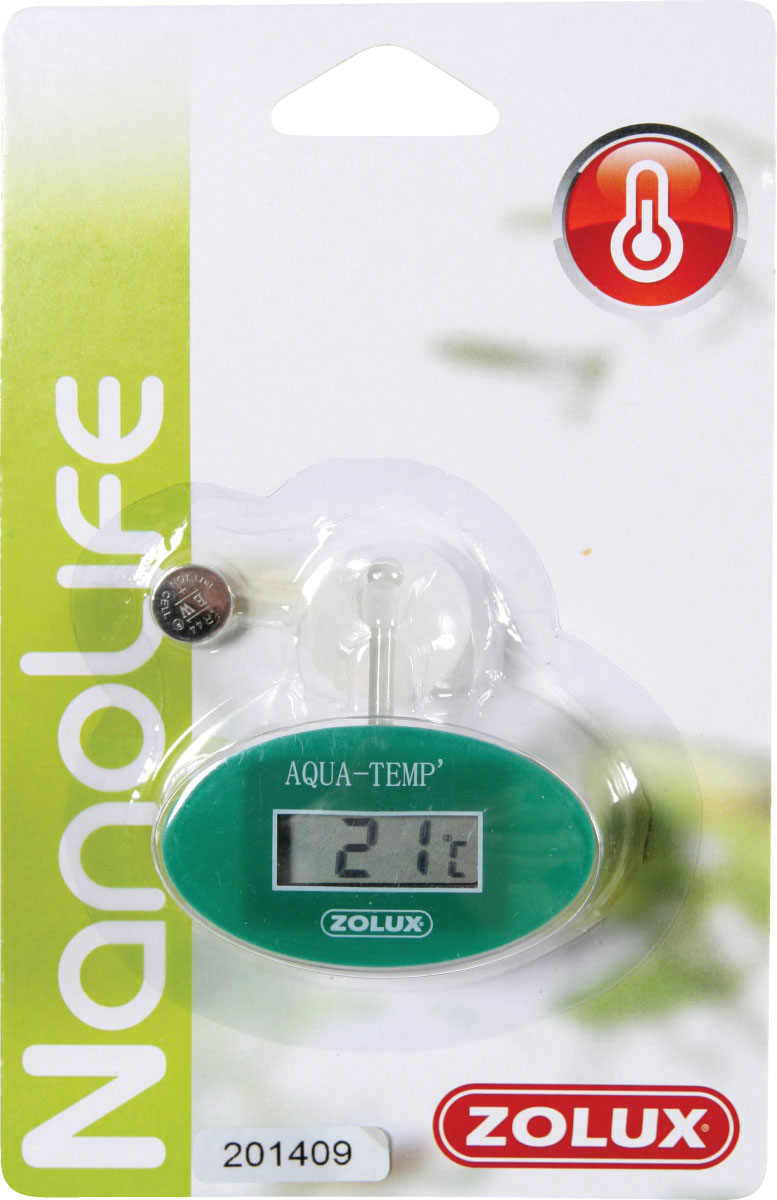
Digital thermometer ref. 334 820
Warning: The heating unit must be immersed before turning it on.
Disconnect the power supply before completely or partially draining the aquarium.
“Safety!” Before doing any work in the aquarium, always disconnect the power supply!
How Big a Heater Do I Need ?
This is directly dependent on the size and environment of the aquarium.
The recommended power of a heater depends on the volume of water and other factors that can vary the temperature such as temperature of the room, is the tank near a heat source, in direct sunlight, in a drafy location, near electrical transformers, what is the type and power of the lighting, etc.
Generally, when the tank is in a normally heated room (~ 18 – 20° C) and does not have any potentially disruptive external factors, the power of the heating unit needed is about 0.8 – 1w per litre water.
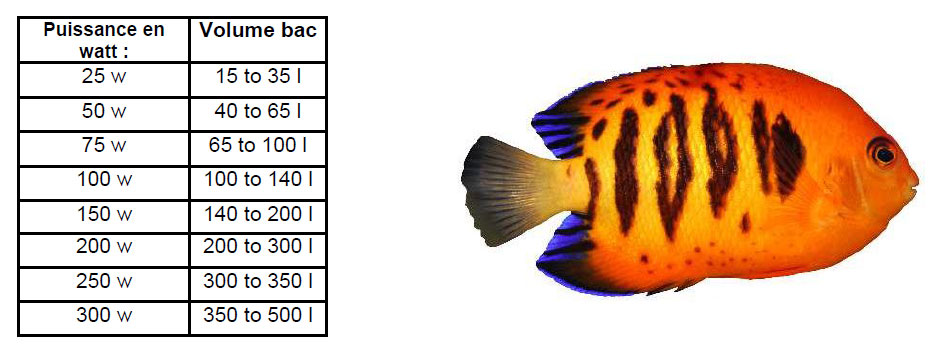
Table of Tank Sizes and Heating Unit Power
The thermostat will then regulate the temperature you have programmed and will have a small margin of power to spare in case of partial and temporary decrease in the temperature of the room.
Zolux Tips: To be sure that you water temperature is maintained at a constant level, it is generally recommended to change the heater after 2 years of service.
Various Types of Heater and Operating Principles
Resistor
The heating part of the system. Always submerged, it is of course completely insulated and sealed (Pyrex glass tube, resin or stainless steel heating cable, etc.). It is generally attached to a thermostat for regulation of the temperature.
Thermostat
Connected to the resistor, this component automatically keeps the temperature in the tank at a constant level. There are two-blade-type “thermal contact” thermostats, and electronic thermostats (submerged or external), generally very precise and reliable.
Combined Heater
A resistor and a thermostat combined in a single device. The “combined” heating device is the most common type on the market. This immersion heater can be: classic (twin blades), electronic or a PTC system (see below).
PTC System
Created from an innovative technology, this system produces resistance (heating) through “molecular friction”. In brief, a polyane film is coated with a layer of resin that holds several million “thermo-generating” microbeads “squeezed in” next to each other. Under voltage, these micro-conductive particles begin to vibrate and generate a very substantial amount of thermal energy; this heat is then transferred immediately to the glass tube, which in turn transfers the heat to the water. This system is controlled by a thermostat.
Additional safety : If the water level in the tank drops (through evaporation or leakage) the PTC system automatically shuts down. In fact, if the resistor overheats, the resin expands and separates the microbeads from each other, thereby breaking the electrical conduction, and thus the generation of heat!)
Substrate Heating
Heating a tank (partially) through the substrate is a reliable and proven system. It is intended primarily for experienced aquarists who want to enhance and develop the natural and vegetative aspects of their aquarium (Dutch and Japanese tanks, etc.) and usually requires supplemental carbon dioxide (see CO2). The system consists of a cord heater (placed at the bottom of the tank and covered with a bottom substrate) and an independent thermostat connected to the cord heater. The thermostat should be set to ~ 1° C below the temperature set for the general heating of the aquarium, so that for each little drop in temperature, the cord heater takes priority.
This process creates a regular, gentle stream of warm water through the ground (reciprocating convection circuit continuously transferring nutrients from the soil surface to the roots) and maintains a rich soil, at a constant, warm temperature that most plants thrive in.
Power in Watts generally recommended for a heating cord is about 25 – 80 W for 150 L of water.
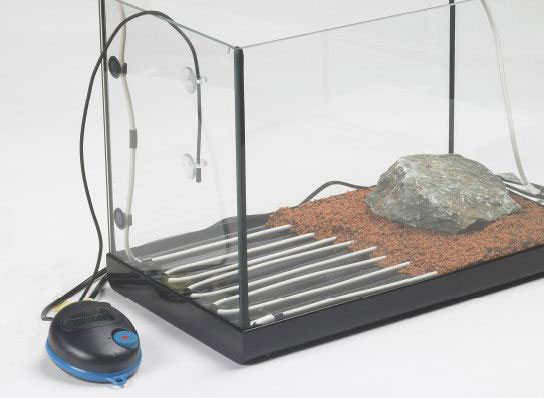
What thermometer should I choose ?
There are several types
- Alcohol thermometer, floating, fixed or planted: classic, practical and reliable
- LCD Digital Thermometer (adhere to the outside of the aquarium). A little less accurate but quite readable at some distance.
- Electronic Thermometers (internal or external): more expensive, but precise, aesthetically pleasing and qualitative.

Precision thermometer ref. 334 802 / Digital thermometer ref. 334820
ZOLUX Tips:
In case of an accidental or programmed drop in room temperature (a winter weekend get-away, power outage, etc.) plan to surround the walls of the tank with insulation (a sheet or blanket, etc.) – this will make the heat loss less rapid and progressive. After a temperature drop, the recovery must also be done very gradually (never use a bucket of boiling water!). If necessary, postpone feeding the fish for 48 hours.
ZOLUX Safety Guarantee:
All our heating systems are certified to CE safety standards (“Low Voltage” and “Electromagnetic Compatibility”)
- LVD directive 73/23/CEE : EN 60 335-1 et EN 60 335-2-55
- CEM 89/336/CEE + 93/68/CEE : EN 55 014-1 et 2/A1.

